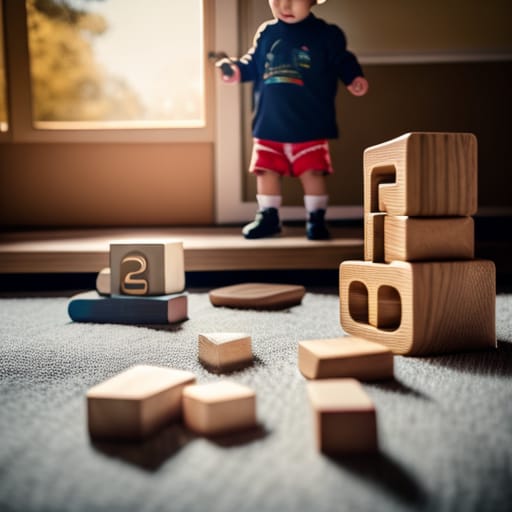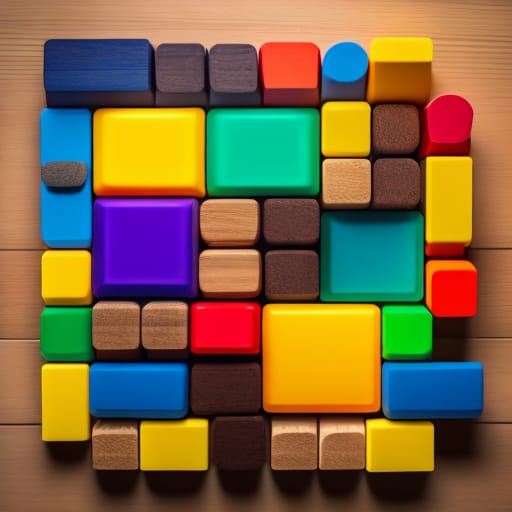Wooden building blocks have captivated children’s imagination for generations. From simple wooden alphabets to more elaborate building block sets, these timeless toys offer a versatile way for kids to learn and creatively explore concepts from STEM to literacy.
As a parent, you may be wondering:
- What are the benefits of large wooden building blocks?
- What features should I look for when choosing a set?
- How can these toys be incorporated into educational activities at home?
This beginner’s guide covers everything you need to know, with tips on selecting the best blocks, maximizing play value, safety considerations, and more!

Benefits of Playing with Wooden Building Blocks
Wooden building blocks offer distinctive developmental advantages:
Fine Motor Skills
- Grasping, carrying, and stacking various sizes and shapes of blocks build dexterity
- Running fingers along engraved letters, numbers, and textures develops tactile skills
Spatial Reasoning and Math
- Concepts of stability, proportions, patterns, measurement, and geometry come alive intuitively
- Counting, sorting, and categorizing blocks build foundations of early math
Creativity and Imaginative Play
- Open-ended possibilities for building and roleplaying spark inventiveness
- Storytelling intrinsically emerges through play
Multidimensional Learning Domains Fostered by Wooden Block Play
| Cognitive | Physical | Socio-Emotional |
|---|---|---|
| Spatial perception | Fine motor control | Self-expression |
| Cause-and-effect | Gross motor skills | Symbolic play |
| Problem-solving | Hand-eye coordination | Cooperation |
| Early math concepts | Balance and posture | Sharing |
What to Look for When Choosing Wooden Building Blocks
While all wooden blocks support creative play, some sets are designed specifically for early learning. Consider these features when selecting blocks:
Size
- Jumbo Blocks – At least 4 inches large, ideal for small hands. Easier for toddlers to grip and maneuver.
- Mixed Dimensions – A variety of large and small blocks adds play diversity. Great for developing comparative concepts.
Materials
- Solid Hardwoods – Maple, beech, and birch have the ideal density for stability yet are lighter than oak. Avoid painted softwoods which can chip over time.
- Smooth Finished Edges – Ensure safe play, especially for toddlers. Avoid sharp corners or splinters.
Educational Elements
- Engraved Alphabets and Numbers – Essential for reinforcing literacy and counting skills through hands-on play.
- Color and Shape Coding – Sorting opportunities to introduce colors, shapes, and patterns. Look for variety.
- Accompanying Guide Book – Select blocks bundled with activity cards or booklets to inspire learning ideas.

Educational Activities to Try with Wooden Building Blocks
Inject learning into playtime with these engaging activity ideas:
Literacy Development
- Spell out names, and simple words using alphabet blocks
- Sound out letter sounds while feeling the engravings
- Stack blocks to form words matching flashcards
Math Concepts
- Count numbers ascending/descending by stacking number blocks
- Explore weight, height, and length comparisons with scale
- Identify shapes and patterns in building creations
Motor Skills
- Test balance by making high towers with alternating or symmetric patterns
- Crawl through or around large hollow block tunnels
- Stack blocks vertically, horizontally, diagonally in different arrangements
Creative and Imaginative Play
- Build dream houses, garages, roadways, or railroads simply following imaginative whims
- Dramatic roleplaying – use blocks as props for airports, landmarks, or farms
- Invent new games with rules incorporating blocks
Collaborative projects with peers introduce cooperative play. Encourage inventing building challenges to stretch spatial reasoning and persistent problem-solving too.
Ensuring Safety
While wooden blocks serve as ideal open-ended tools lacking headaches of electronics, batteries, or internet connectivity, do note safety:
- Supervise play under the age of 3 years – avoid small pieces if still mouthing objects
- Check for detachable elements like people or animal figures which could loosen and become choking hazards
- Store blocks when not in use to avoid tripping accidents and extend longevity
Proper care also prevents damage – keep blocks dry, and clean with non-toxic cleaners avoiding harsh chemical use.

Fostering the Full Value from Building Block Play
More than just toys, wooden building blocks offer pads for multidimensional skills if kids have space for free play and guidance at times.
Allow self-directed exploration – don’t instruct or interfere unnecessarily. Discovery through trial and error enables organic learning.
Ask open questions to stretch thinking – “What other shapes could we combine here?” “How else might we build this component?”
Make observations to introduce new concepts – “Look we made symmetrical patterns here” or “Let’s organize all the vehicles together”.
Your role is not to entertain or even necessarily teach – it is facilitating an enriching environment for your child to learn through their own self-determined play.
The Bottom Line
Fundamentally, wooden building blocks provide unique developmental benefits that modern alternatives like plastic just can’t match. Making them cornerstone toys through promoting creative, engaged play starting young lays sturdy foundations across cognitive, physical, and social-emotional realms.
Hopefully, this beginner’s guide provided helpful insights into maximizing the magic of wooden block play while selecting the best block sets for your kids’ individual learning needs and styles.
The options are vast – now start building towards success!
Frequently Asked Questions
What are the best large wooden building blocks for toddlers?
The best wooden building blocks for toddlers are jumbo-sized (at least 4 inches large) with smooth rounded edges for safety. Sets with engraved alphabets, numbers, and shapes are ideal for reinforcing early literacy and math concepts through hands-on play. Many toddlers also enjoy accessories like characters, signs, and vehicles.
Should I choose wood or plastic building block sets for my preschooler?
Wooden building blocks offer superior durability, versatility, and learning value over plastic alternatives. Made from eco-friendly materials, the heft of wood develops stronger motor skills. Its smooth tactile quality builds fine sensory perception. Wooden blocks also lend themselves better to crafting imaginative structures from toddlerhood through elementary school.
What safety precautions should I take with wooden blocks?
Check wooden blocks for detachable components which could loosen and pose choking hazards for kids under 3 years. Supervise young children actively during play. Remind kids not to throw blocks or build dangerously high unsupported structures. Store blocks properly when not in use to prevent potential tripping accidents and ensure the longevity of the blocks.
How can alphabet blocks help my child learn?
Beyond just recognizing letter shapes, engraved alphabet blocks allow kids to connect writing, reading, and phonics skills through hands-on sensory play. Feeling the curves of letters while verbalizing sounds builds motor, visual, and auditory connections for memory and literacy development essential to reading readiness. Guide kids to build words, match letters to flashcards, and incorporate alphabet play into stories for maximum learning value.
What are the most important things I should look for when selecting wooden block sets?
Prioritize sets made from smooth-finished solid hardwoods over plastic alternatives for superior durability, versatility, and eco-friendliness. Look for variety in engraved patterns, shapes, and accessories to inspire multi-dimensional play opportunities – open-ended play value is key. For toddlers, opt for jumbo 4″+ sized blocks which are easier to manipulate. Accompanying learning guides offer helpful pointers too. Balance structured engraved blocks with some blank blocks to spur freeform creativity too!
Can I make DIY building blocks at home?
You certainly can make easy no-frills building blocks from wood scraps or youth-sized shipping pallets using basic tools. Sand edges smooth, use non-toxic wood glues, and allow thorough drying before use. For intricately engraved blocks, however, you’ll require a wood carving expert. We still recommend purchasing quality building blocks for developmental and safety assurances – it’s an investment in years of enriching play!